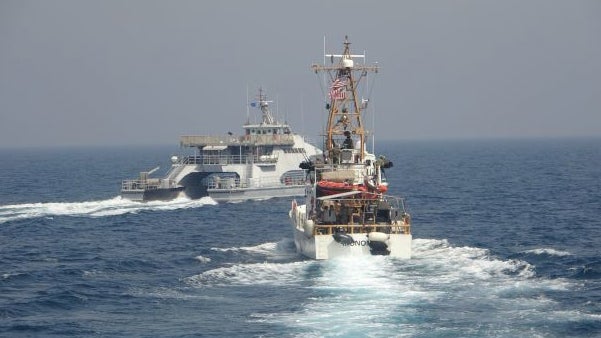The U.S. Navy has released video and images showing an encounter between two U.S. Coast Guard cutters and an Iranian Islamic Revolutionary Guard Corps catamaran in the Persian Gulf earlier this month. In what the U.S. Navy describes as an “unprofessional interaction” by Iran, the Revolutionary Guard Corps boat Shahid Nazeri is seen crossing at high speed in front of the Coast Guard vessels, reportedly coming as close as 70 yards to the American ships, which have to take evasive action to avoid it.
The incident, first reported yesterday by the Wall Street Journal, took place on April 2. However, the U.S. Navy released the imagery today, noting in a statement that the Islamic Revolutionary Guard Corps Navy (IRGCN) boat had “repeatedly crossed the bows of the U.S. vessels at an unnecessarily close range, requiring U.S. ships to make defensive maneuvers to avoid the risk of a possible collision.”
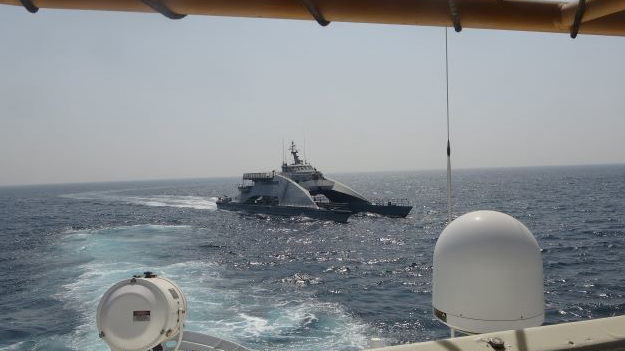
The U.S. Navy says that the Harth 55 class Shahid Nazeri was accompanied by three fast attack craft (FAC) or fast inshore attack craft (FIAC) of undisclosed types during this incident. The IRGCN operates a wide array of small boats in these general categories. The Shahid Nazeri is a larger catamaran-type, high-speed design that appears to be armed with a 20mm cannon and has a helipad on top of its rear deck.

The U.S. Coast Guard (USCG) boats involved were the USCGC Wrangell (WPB-1332) and USCGC Monomoy (WPB-1326), two Island class patrol cutters. They were conducting routine maritime security patrols in the southern Persian Gulf, according to the U.S. Navy, which said that these patrols are routinely carried out in international waters.
The Harth 55 crossed the bows of both Wrangell and Monomoy at a 70-yard closest point of approach (CPA), according to a U.S. Navy statement. The Iranian boat then “closed aggressively” on Wrangell’s bow, and the cutter maneuvered out of its path while sounding five short warning blasts from the ship’s horn.
As well as sounding the horn, the crews on the two USCG ships also issued “multiple warnings” to the Iranians over open radio channels. The U.S. Navy says the IRGCN vessel responded to the bridge-to-bridge radio queries, but it’s unclear how these conversations went. Regardless, according to the U.S. Navy account, the Harth 55 continued its “unsafe and unprofessional” maneuvers before eventually moving away from the cutters. The entire incident lasted for roughly three hours.

“U.S. naval forces continue to remain vigilant and are trained to act in a professional manner, while our commanding officers retain the inherent right to act in self-defense,” the U.S. Navy release concluded.
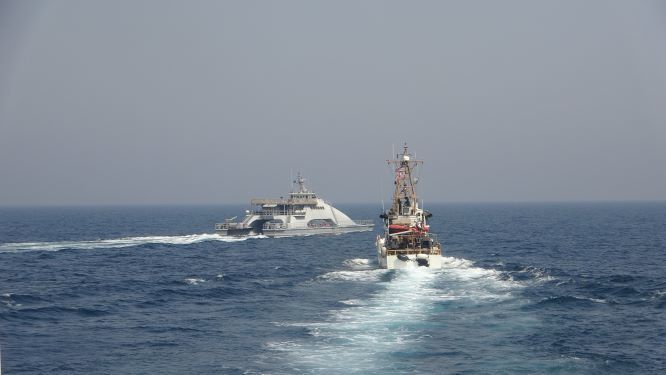
The appearance of the Shahid Nazeri, which was officially commissioned in 2016, is notable in itself, given how little time the vessel seems to spend at sea. The catamaran did make participate, at least one some level, in a Russian-Iranian naval exercise earlier this year. The ship’s actual capabilities have long seemed very limited, though the IRGC has released pictures in the past showing an AB-206 helicopter armed with an anti-ship missile onboard.
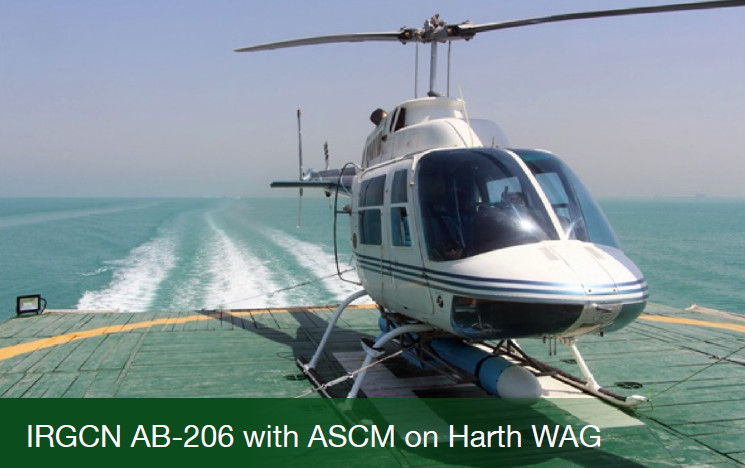
Iran now appears to be in the process of constructing at least one example of a new class of catamarans, reportedly named the Shahid Soleimani class. There are indications that this new design will itself be armed with anti-ship missiles.
This is, of course, hardly the first time that USCG vessels, as well as other American warships, have been involved in a maritime altercation with Iranian forces. Almost a year ago, on April 15, 2020, the USCGC Wrangel, together with another Island class patrol cutter, USCGC Maui, was involved in another incident in the same waters.
On that occasion, the cutters, together with the expeditionary sea base USS Lewis B. Puller, the Arleigh Burke class destroyer USS Paul Hamilton, and the Cyclone class patrol craft USS Firebolt and USS Sirocco were harassed by around 11 Iranian speedboat-type craft. You can read more about that incident here.
The incident this April followed a very similar pattern to last year’s encounter. On both occasions, IRGCN vessels repeatedly crossed the bows of the U.S. vessels at extremely close range and high speeds. However, last year’s incident saw the Iranian boats coming as close as 10 yards of at least one of the U.S. vessels, according to U.S. Naval Forces Central Command.
Despite the use of radio communications, blasts from the ships’ horns, and long-range acoustic noise maker devices, there was no response from the IRGCN on that occasion.
An earlier video showing the April 15, 2020 incident in the Persian Gulf:

For the U.S. Navy, these kinds of actions on the part of Iran present a significant risk of a potentially catastrophic collision. Although the Island class ships are relatively small, at 110 feet long and with a displacement of up to 165 tons, it still takes some time to bring them to a stop. Perhaps more worrying is the risk of mistaking these high-speed interactions by armed boats as a genuine attack.
It is not known if there were U.S. Navy warships on the scene to provide additional protection to the USCGC Wrangell and USCGC Monomoy, but these boats do have their own, limited, defensive armament in the form of a Mk 38 25mm chain gun and a pair of 50-caliber machine guns.
U.S. vessels are also increasingly working in cooperation with air support assets, including U.S. Air Force AC-130W Stinger II gunships and U.S. Army AH-64E Apache attack helicopters, both of which can defend against swarming attacks by Iranian boats. Air Force A-10 attack aircraft have also regularly trained for similar maritime missions in the past.

Aside from the aforementioned April 2020 encounter, and the latest altercation, Iran has long sparred with U.S. military vessels in the Persian Gulf, to the point where such provocations became almost routine. Back in 2017, The War Zone reported about how harassment of American warships by the IRGCN in the Gulf was an extension of the more hardline domestic and foreign policy objectives pursued by the country’s Supreme Leader and other unelected clerics rather than its elected government. Above all, this sought to provide a bulwark against U.S. influence and military presence in the Middle East.
A year before that, in January 2016, IRGCN forces captured 10 American sailors and two Riverine Command Boats that had drifted into Iranian territorial waters near Farsi Island, resulting in an international incident. One of the craft had suffered an engine breakdown and lost track of its position.
However, these kinds of maritime altercations had largely come to an end by the middle of President Donald Trump’s term in office amid new hardline U.S. policies toward Iran. Of course, there were still other provocations. In 2019, the United States and Iran came worryingly close to blows after Iran shot down a U.S. Navy RQ-4A Broad Area Maritime Surveillance Demonstrator (BAMS-D) over the Gulf of Oman. This was followed by U.S. Marines aboard the Wasp class amphibious assault ship USS Boxer bringing down an Iranian drone in the Strait of Hormuz.
Iran also continued its practice of conducting hostile boardings of other vessels underway in the Persian Gulf, in the highly strategic Strait of Hormuz, and elsewhere. The IRGC typically employs swarms of small boats, as well as helicopters, to conduct these operations.
In one high-profile incident, the IRGC seized control of the British-flagged oil tanker Stena Impero in July 2019, in response to the United Kingdom detaining an Iranian supertanker off the coast of Gibraltar. There have been other examples, too, while the U.S. government has also blamed Iran for a spate of attacks directed against commercial oil tankers.
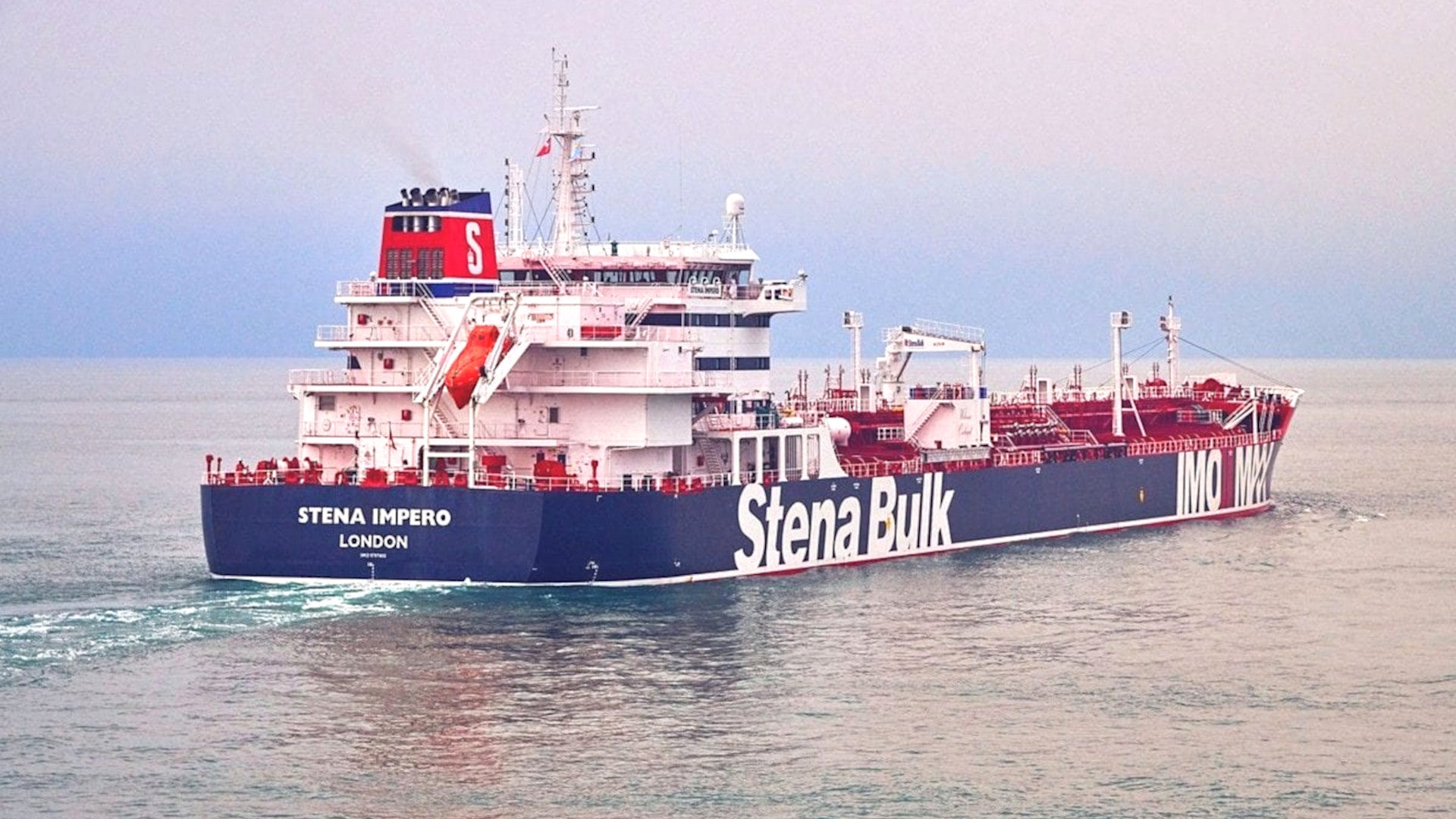
Both the United States and the European Union have since established new maritime security constructs to help ensure the safe passage of commercial shipping through the Strait of Hormuz, specifically.
Meanwhile, and more generally, tensions between the United States and Iran ratcheted up again in January last year, including the U.S. government’s assassination of Iranian General Qasem Soleimani in Baghdad and the Iranian ballistic missile strikes aimed at U.S. forces.
After President Biden took office earlier this year, a rocket attack on Erbil Airport in northern Iraq in February week killed a contractor working for the U.S.-led coalition fighting ISIS in Iraq and Syria and injured a U.S. military service person, among other casualties. In retaliation, the U.S. military launched strikes against Iranian-backed militias in Syria. That event confirmed that Biden would continue the campaign against Iranian-supported groups.
The latest incident involving the two USCG cutters and the Shahid Nazeri came at almost the same time that the U.S. and Iran announced they would begin negotiations toward the U.S. government rejoining a controversial 2015 multinational accord on Iran’s nuclear activities, from which Trump withdrew the United States in 2018. Biden has said in the past that Iran will get no sanctions relief until it returns to full compliance with this agreement, known formally as the Joint Comprehensive Plan of Action (JCPOA), and which aims to put checks and limits on Tehran’s nuclear ambitions, but there have been reports that the U.S. government may be increasingly flexible on that issue.
Despite that breakthrough, tensions between Tehran and Washington apparently seem set to continue. The incident in the Persian Gulf earlier this month is unlikely to be the last of its kind in this long-running standoff. What is less certain is whether this signals a return to such altercations between U.S. and Iranian military vessels becoming commonplace.
Contact the author: thomas@thedrive.com
